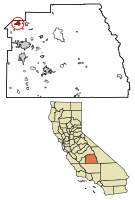Dinuba, California | |
|---|---|
 Local parade supporting the Korean March 1 Independence Movement (1920) | |
| Nicknames: Raisin City, Raisinland U. S. A., Dina | |
| Motto(s): Together, A Better Community | |
 Location of Dinuba in Tulare County, California | |
| Coordinates: 36°32′42″N 119°23′21″W / 36.54500°N 119.38917°W | |
| Country | |
| State | |
| County | Tulare |
| Incorporated | January 6, 1906[1] |
| Government | |
| • Mayor | Maribel Reynosa[2] |
| • Vice Mayor | Rachel Nerio-Guerrero[3] |
| Area | |
| • Total | 6.51 sq mi (16.86 km2) |
| • Land | 6.51 sq mi (16.86 km2) |
| • Water | 0.00 sq mi (0.00 km2) 0% |
| Elevation | 335 ft (102 m) |
| Population (2020) | |
| • Total | 24,563 |
| • Density | 3,773.12/sq mi (1,456.92/km2) |
| Time zone | UTC-8 (Pacific) |
| • Summer (DST) | UTC-7 (PDT) |
| ZIP code | 93618 |
| Area code | 559 |
| FIPS code | 06-19318 |
| GNIS feature IDs | 1658422, 2410342 |
| Website | www |
Dinuba is a city in Tulare County, California, United States. The population was 24,563 at the 2020 census, up from 21,453 at the 2010 census. It is part of the Visalia-Porterville metropolitan statistical area. The Alta District Museum is located in Dinuba in a restored railroad station; the museum has a collection of materials that illustrate local history.[6]
The name of the city is of unknown origin. While various theories about the origin exist, none have been verified. It probably is a fanciful name applied by railroad construction engineers at the time the branch line was built in this area. The city's original name was Sibleyville, named for James Sibley, who deeded 240 acres to the Pacific Improvement Company (Southern Pacific Company).[7]
In the first quarter of the 20th century Dinuba had a sufficient Korean-American population to organize a parade supporting Korean independence from Japan on the second anniversary of the founding of the March 1st Movement in 1920.
- ^ "California Cities by Incorporation Date". California Association of Local Agency Formation Commissions. Archived from the original (Word) on November 3, 2014. Retrieved August 25, 2014.
- ^ "City Council". City of Dinuba. Retrieved January 12, 2019.
- ^ "City Council". City of Dinuba. Retrieved January 12, 2019.
- ^ "2020 U.S. Gazetteer Files". United States Census Bureau. Retrieved October 30, 2021.
- ^ "Dinuba". Geographic Names Information System. United States Geological Survey, United States Department of the Interior. Retrieved January 13, 2015.
- ^ Alta District Museum
- ^ Erwin G. Gudde, California Place Names: The Origin and Etymology of Current Geographical Names, 4th ed., revised and enlarged by William Bright (Berkeley: University of California Press, 1998), p. 110

